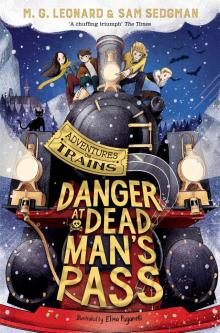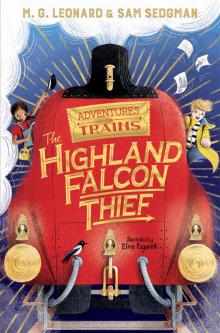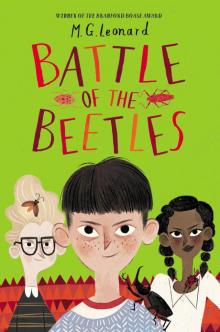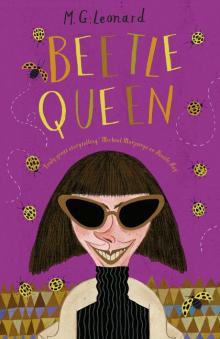- Home
- M. G. Leonard
The Arctic Railway Assassin Page 3
The Arctic Railway Assassin Read online
Page 3
While Uncle Nat paid for the horse, and the stall keeper wrapped it in a paper bag, Hal glanced at the next stall, where a woman in blue and red robes was selling carved jewellery made from reindeer antlers. A girl about Hal’s age was sitting beside her, also dressed in a blue robe and a red hat. She was playing with the end of one of her long brown plaits and looking bored.
‘There are reindeer in Sweden?’ Hal asked his uncle.
‘Oh yes,’ said Uncle Nat, following Hal’s gaze to the woman in traditional dress. ‘The Sámi people are famous reindeer herders. They’ve lived in the north of Sweden, Norway, Finland and Russia for centuries. If we’re lucky we may see reindeer in Kiruna.’
‘Look at these.’ Hal was drawn to a stall selling little wooden men in cheery red robes, only their bulbous noses visible between their curly beards and red hats.
‘Tomte gnomes. They’re supposed to look after your home.’
‘Can we get one for Ellie?’ Hal asked. ‘They’re cute.’
Uncle Nat found a brass nutcracker shaped like an alligator, which crunched chestnuts between its jaws. ‘James will love this. He can roast the chestnuts on our hearth.’
Hal found himself staring at the Sámi girl on the next stall and wondering whether she was a reindeer herder. He thought it would be a brilliant thing to do. He made a note of her interesting dress, deciding to draw it later.
‘I don’t know about you, but I could do with a hot drink,’ Uncle Nat said. ‘There’s a cafe serving drinks from a hatch over there.’
Hal saw two chalkboard menus on the wall either side of the window. One in Swedish, and one in English saying TAKEAWAY DRINKS – SANDWICHES – SWEETS.
‘Does everyone in Sweden speak English?’ Hal wondered as they joined the short queue for drinks.
‘Not everyone, but most Swedes know a bit of English.’
Uncle Nat ordered a hot chocolate, a coffee and a couple of cinnamon buns. As he lifted the hot drinks from the waitress in the cafe hatch, a woman in a camel-coloured coat, wearing a leopard-print headscarf and oversized sunglasses, bumped into him. He jumped back to avoid spilling the drinks down his front.
‘Jag är ledsen,’ the woman said, while, quick as a flash, Hal saw her slip her hand into Uncle Nat’s coat pocket and pull out his wallet.
‘Jag är ledsen!’ Hal yelled, not knowing what it meant, as he whacked the flat of his hand down onto the woman’s arm. She dropped the wallet, glancing at Hal over her shoulder as she hurried away into the market.
‘What on earth . . . ?’ Uncle Nat exclaimed.
Hal bent down and picked up the wallet from the ground. Taking his hot chocolate, he handed it back to his uncle, noticing that the Sámi girl was watching him.
CHAPTER FIVE
KUNGSTRÄDGÅRDEN
‘Are you all right?’ Hal asked his uncle.
‘Didn’t spill a drop,’ Uncle Nat reassured him, with a smile. ‘Let’s perch on those steps for a bit.’ He nodded towards a building with an imposing facade: steps leading to a pair of glass doors with a giant gold medal emblazoned on them. On the medal was the profile of a man’s head.
‘That’s the Nobel Prize Museum!’ Hal exclaimed. ‘Is that where you were last night?’
‘No, the banquet is at the City Hall.’ Uncle Nat brushed the snow off a step before sitting down. ‘Well done on stopping that pickpocket.’ He handed Hal a cinnamon bun. ‘That was quick thinking. We would have been a bit stuck without my bank cards.’ He looked out across the square and took a sip of coffee. ‘I should’ve known touristy places like this are a magnet for pickpockets.’
‘Oh wow!’ Hal’s eyes widened as he took a big bite. ‘These are the softest, most delicious buns I’ve ever tasted.’ It was gone in five mouthfuls. Dusting off his hands, Hal took a swig of his hot chocolate, then pulled out his sketchbook and pen while he still had an image of the pickpocket in his mind’s eye.
Uncle Nat watched him call her likeness onto the page with only a few lines. ‘You’re getting really fast.’
‘I’ve been practising.’
‘What did you make of Morti’s story last night?’
‘I have questions,’ Hal replied. ‘I wanted to talk to her today about it, on the train.’
‘What would you have asked her?’
‘Well, according to her, after her husband was arrested, she went back to doing her research and everything was normal.’
‘Yes. It was.’
‘How long for?’
‘Nearly two years.’
‘And then two months ago she was burgled.’
‘Yes.’
‘So what happened two months ago to start the strange things happening?’
Uncle Nat blinked at this simple question. ‘Well, I suppose that was when the winners of the Nobel Prize were announced. The ceremony comes two months later.’
‘Then that announcement – or possibly something else – made someone start doing these things to Morti,’ Hal reasoned. ‘I think either someone is angry or jealous and wants to punish Morti for getting such a big prize, or . . . someone thinks she has the Kill Code and is looking for it.’
‘But she doesn’t.’
‘Morti may think she’s destroyed all her husband’s work, but what if she hasn’t? Or she has, but someone thinks she hasn’t.’
‘Morti is thorough.’ Uncle Nat shook his head. ‘She told me that she’d put everything of Björn’s into boxes and had it incinerated. She wiped the hard drive of his computer and then donated it to a local school. She moved out of their house into a small apartment and got a new laboratory. She’s tried to have a completely fresh start. I don’t see how she could have that Kill Code.’
‘Then somebody is really jealous.’ Hal looked down at the picture of the pickpocket in his sketchbook. ‘You were with Morti at the Nobel ceremony. Perhaps that’s made you a target.’
‘I don’t think so.’ Uncle Nat waved this idea away with his hand. ‘I’m glad we’re getting on a train to the Arctic later this afternoon. We can leave all of this Kill Code business behind.’
‘I wouldn’t mind if there was a crime to solve on the train.’ Hal finished his hot chocolate and smacked his lips. ‘Being on a train and solving crimes with you is the best thing in the world.’
Uncle Nat smiled. ‘I’m not sure your mum would agree.’
‘Yeah, but she’s not here, is she?’ Hal pointed to the glass doors behind them. ‘Can we go in the Nobel Prize Museum?’
‘Yes, but we’re not investigating anything.’
‘Whatever you say,’ Hal replied, getting to his feet and grinning.
Hanging from the ceiling of the main hall of the Nobel Museum were posters of every previous Nobel Prize winner. Morti wasn’t up there yet. Hal discovered that Alfred Nobel became rich when he invented dynamite, for use in mining. He was later criticized for making money from war, so he set up the Nobel Prize in 1901, giving all his money to fund awards in medicine, physics, chemistry, literature and peace.
Hal thought about dynamite. It was something that could be used for good, helping humans mine the earth for minerals, but it could also be used to hurt people, by blowing them up. It seemed to him that this dilemma mirrored what Morti had described with the sonic frequencies. Her magic frequency could be used to get rid of cancer, which was amazing, but the Kill Code, a sound that could kill someone, was terrifying.
They came to an exhibit all about the annual Nobel banquet that took place in Stockholm City Hall. ‘It says here that the prizes are awarded to the new laureates by the Swedish king,’ Hal read from a plaque. ‘Did you meet the king last night before you came to the airport to get me?’
‘Yes, Carl XVI and Queen Silvia,’ Uncle Nat replied, ‘but only for a minute.’
Hal glanced at his uncle, impressed.
‘Look.’ Uncle Nat pointed at a wall with a giant blown-up newspaper article on it. ‘There’s Morti.’
They read the article, which explained who the five winners were this year and why. Beside four other portraits was a picture of Morti. Hal studied it. She was wearing a serious expression, lab coat and looking every bit the scientist. A sombre polo neck and trousers, no chunky necklace of hexagons, but a simple chain with a ring suspended from it. It was the portrait of a Nobel Prize winner.
‘We’ve a few hours before we have to be at the station for the night train,’ Uncle Nat said, glancing at the three wrist watches on his left arm. ‘There’s so much I could show you in Stockholm, but I really want to take you on the metro.’
‘The underground?’ Hal was surprised.
‘The Stockholm metro has been described as the world’s longest art gallery. Most of the stations have installations, paintings or mosaics created by over a hundred artists, and they’re wildly different from one another. Let’s go back to the hotel and grab our bags, then we can hotfoot it over to Kungsträdgården, the King’s Garden, and get the metro to Central Station. We’ll pick up a sandwich and some fruit there, for lunch.’
They made their way through the winding streets of Gamla Stan and on to the Strömbron bridge. Hal glanced back at the island and thought he saw a figure dart into a doorway. He frowned, but said nothing to his uncle, who was talking about some king called Gustav III who’d been assassinated at a masked ball. He looked back several times, but saw nothing. Was his imagination playing tricks on him again? Thinking about the Kill Code must have unnerved him, because he felt as though they were being followed.
When they reached the hotel, Uncle Nat peered at him. ‘Hal, are you all right?’
‘Yes, just cold,’ Hal reassured him.
‘Let’s get inside and warm up a bit while we get our bags. It’s only a ten-minute walk to the metro station and it won’t be cold underground.’
When they emerged from the Grand Hotel with their bags, fresh flakes of snow tumbled from the battleship-grey sky.
Hal marvelled at the strangeness of the light. ‘Is it getting dark already?’
‘Yes. Unnerving, isn’t it?’ Uncle Nat said, obviously enjoying the strangeness. ‘This way.’ He strode off, and Hal followed him to Kungsträdgården park. He occasionally glanced about, or turned suddenly, but he didn’t see anything or anyone suspicious.
The park was lit up by thousands of fairy-lights in chains from tree to twinkling tree. Towering reindeers made of lights guarded the four corners of a piazza, and in the middle of the park, smiling people whirled around a colourful ice rink. The smell of burnt sugar, the gaiety of the festive lights and the happy skaters whirled Hal’s dark thoughts away.
‘Over there.’ Uncle Nat pointed at a signpost with a white lamp illuminating a bold blue T. ‘That’s the sign for the metro.’
They crossed a road with tram tracks and turned a corner to the entrance. Between the silver double doors stood a red stone statue of a bearded man dressed as a Viking or gladiator, Hal wasn’t sure which.
Inside, escalators swept down into the floor and the low ceiling above them sloped at the same angle as the moving stairs. The station was quiet. Hal felt like he was descending into the bowels of the earth. ‘This is a really long escalator.’
‘Kungsträdgården is the deepest metro station in Stockholm.’ Uncle Nat said, stepping off and turning to see Hal’s reaction to the incredible cavern painted with patchwork patterns of red, green and white.
‘It’s like a prehistoric cave!’ Hal exclaimed.
‘When they dug out the stations, they sprayed the rock face with concrete, instead of cladding it. That’s what makes it feel like a cave.’
Hal rushed over to a barrier and looked down into an illuminated granite pit containing bits of columns and ornate stone cornices from buildings. ‘What’s this?’ There were plants and moss growing between them, and to the side an iron lamp post. ‘It looks like an archaeological dig.’
‘These are relics collected when Stockholm was redeveloped,’ Uncle Nat replied, coming to stand beside him. ‘But the most interesting thing about this station is that scientists recently discovered it has a unique ecosystem.’
‘Ecosystem?’ Hal looked around.
‘Yes. Living down here are crane flies, fungus, unusual types of moss and a rare cave dwarf spider that shouldn’t be found in this part of the world. I read that the ecosystem thrives on the chalk that drips from the ceiling, the artificial light and the human detritus that we shed as we pass through it.’
‘Detritus?’ Hal asked, noticing tiny rivulets of water and green algae growing on the wall closest to him.
‘Skin cells, hair, that kind of thing.’
Hal winced at this fact. It was gross.
They walked through the cavernous hall with its green ceiling until the way split left and right, leading to two train platforms. Standing at the intersection was a salmon-coloured statue of a naked man. Uncle Nat pointed to a blue train waiting for passengers. They stepped into a mustard-yellow carriage and sat down. They were the only people in it. Just as the doors were closing, a girl wearing a sandy-coloured beanie and thick scarf hurried on, walking past them to sit at the far end. She had headphones on and was bobbing her head to music.
As the train moved away into the tunnel, Hal pulled out his sketchbook and doodled a picture of the Kungsträdgården station. He had never imagined a metro station could be so weird and wonderful. As his pen marked the page, he felt like he was leaving the Kill Code mystery behind. Soon they would be at Central Station, and boarding a train to the Arctic.
CHAPTER SIX
DRAWING INSTRUMENTS
Central metro station wasn’t as magical as Kungsträdgården, but it was fantastic. The cavernous walls and ceilings were painted in a floral pattern of blue and white. One day, Hal thought, he’d like to travel the full length of the metro and see every single station.
Rising on an escalator, they found themselves in the middle of a bustling shopping centre. Uncle Nat pointed to a supermarket. ‘Let’s get ourselves lunch and snacks for the journey.’
Hal chose a cheese roll, a bag of crisps, a bottle of water and two large bars of Plopp chocolate. He found the name funny and decided to give one to his dad for Christmas.
As soon as they were out of the supermarket, Hal ate his roll. Walking around a city made you hungry.
‘We’re early,’ said Uncle Nat. ‘But usually you can board a sleeper train a while before departure. Shall we find out?’
Hal nodded eagerly. He couldn’t wait to explore their compartment, get cosy, and set out on their adventure to the Arctic.
The entrance to the overground station was at the other end of the shopping centre. The waiting hall had a high, arched ceiling, with a bank of departure screens. Hal and Uncle Nat examined them before marching happily through the ticket barriers towards platform twelve, which turned out to be a stark, plain concrete strip.
‘What time is it?’ Hal asked as they walked along the platform.
‘Two fifty-five.’
‘It’s dark.’ Hal looked up at the sky, feeling disoriented. ‘It could be nine o’clock at night.’
‘Stockholm only gets an hour of full sunlight a day in December,’ Uncle Nat told him. ‘When we arrive in Abisko, we’ll be above the Arctic Circle. There’ll be no sunlight at all.’
‘It’s dark all day?’
‘Reflected light, off snow, creates an otherworldly light that you wouldn’t call daylight, but you can see by it.’ Uncle Nat was looking up and down the empty platform. ‘There’s no sign of our train. Let’s ask the station guard when it will arrive.’
Looking across at the row of stark platforms opposite, all under corrugated iron roofs, where people were waiting or boarding trains, Hal spotted the girl from the metro, with her sandy beanie and headphones. She seemed to feel his gaze and looked up. He caught her eye and smiled, but she looked away and a train pulled into her platform – dove grey with silver carriages. There was a functional, bold feel to the design of Swedish rolling stock that Hal liked. When the grey train pulled out of the station, the girl was gone.
‘Seems there’s going to be a bit of a delay,’ Uncle Nat said, ushering Hal back to the stairs. ‘Heavy snowfall has caused an accident. There’s a bridge down. All trains are being redirected inland to avoid that section of track.’
‘What does that mean?’
‘Our train will be late arriving. However, the guard thinks it won’t leave much later than timetabled. He said we should wait downstairs in the ticket hall, where it’s warm. There’ll be an announcement when it arrives.’
‘Will we still be able to get to Abisko?’
‘Yes, but our train will travel a longer route, to avoid the bridge. We’ll arrive later than planned.’
Hal didn’t think spending more time on the train was so bad.
At the foot of the stairs, on the busy concourse underneath the platforms, Uncle Nat found them a seat on a bench and left Hal with the bags while he ventured off in search of more coffee.
On the opposite benches was a group of people, each travelling with a different musical instrument. A short man with wild grey hair and expressive eyebrows was talking loudly, waving his hand.
While he waited for his uncle to return, Hal pulled out his sketchbook and drew the fascinating ensemble with their interestingly shaped luggage.
On the blank page he swiftly and loosely drew a series of eggs for heads, tipping them to the right angle, then he marked the ends and back of the bench and drew marks for knees and feet. He’d been practising drawing at speed for a year and a half now, and was able to get down all the important lines at a breakneck pace. At one end of the bench stood an instrument case the size of a man, and Hal immediately knew it had to be a double bass. It was strapped with a bungee cord to a little trolley. The man sat beside it was tall and cheery-looking. He had a thicket of tight corkscrew curls, and his arm was around the woman beside him. She had a cherubic face and long hair that draped over her shoulder. Her head was tipped against his chest while her arm lazily lay over a cello case between her knees. Hal guessed they were a couple. Next to them were three women chatting and laughing. The first woman had a mane of red hair flopped over her head revealing a shaved undercut. She had a black briefcase on her lap which Hal guessed was either for an oboe or a clarinet. It had a sticker on it that said The Dynamic Dozen. The capital Ds were bass clefs and the z was a treble clef. The blonde girl giggling beside her had a violin case at her feet, and next to her was the girl who was telling the funny story. She had cat-eye glasses and curly hair that framed her mischievous moon face. The music case at her feet was large and strangely shaped. Hal wasn’t sure what it was. It too had a sticker saying The Dynamic Dozen.

 Danger at Dead Man's Pass
Danger at Dead Man's Pass The Highland Falcon Thief
The Highland Falcon Thief Revenge of the Beetle Queen
Revenge of the Beetle Queen Battle of the Beetles
Battle of the Beetles Beetle Queen
Beetle Queen